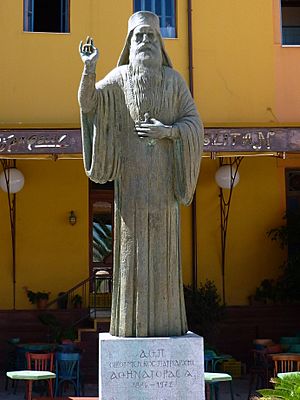Athenagoras I of Constantinople facts for kids
Quick facts for kids Athenagoras I |
|
|---|---|
| Ecumenical Patriarch of Constantinople | |

Ecumenical Patriarch Athenagoras I in 1967
|
|
| Enthroned | November 1, 1948 |
| Reign ended | July 7, 1972 |
| Predecessor | Maximos V |
| Successor | Demetrios I |
| Personal details | |
| Birth name | Aristocles Matthew Spyrou |
| Born | 6 April [O.S. 25 March] 1886 Vasilikón, Janina Vilayet, Ottoman Empire (now Epirus, Greece) |
| Died | July 7, 1972 (aged 86) Phanar, Istanbul, Turkey |
| Denomination | Eastern Orthodox Church |
| Alma mater | Holy Trinity Theological School |
Athenagoras I (Greek: Αθηναγόρας Αʹ), whose birth name was Aristocles Matthaiou Spyrou (Greek: Αριστοκλής Ματθαίου Σπύρου), was an important leader in the Eastern Orthodox Church. He was born on April 6, 1886, and passed away on July 7, 1972.
He served as the Greek Orthodox Archbishop of North and South America from 1930 to 1948. After that, he became the 268th Ecumenical Patriarch of Constantinople, a very high position, from 1948 until his death in 1972. He is especially remembered for his efforts to bring different Christian churches closer together.
Contents
Biography
Athenagoras was born as Aristocles Matthew Spyrou on April 6, 1886. His birthplace was the village of Vasiliko, near Ioannina, in a region called Epirus. At that time, this area was part of the Ottoman Empire. His father, Matthew N. Spyrou, was a doctor. His mother was Helen V. Mokoros.
Athenagoras became interested in religion at a young age. His mother and a local priest encouraged him. After finishing his high school education in 1906, he went to the Holy Trinity Theological School. This school was located at Halki, near Istanbul. In 1910, he was ordained as a deacon.
Early Church Service
After graduating, he became a monk and was given the name Athenagoras. He was also ordained to the diaconate, which is a role in the church. He served as an archdeacon in one church area. Later, in 1919, he became a secretary for Archbishop Meletius (Metaxakis) of Athens.
While still a deacon, he was chosen to be the Metropolitan of Corfu in 1922. A "Metropolitan" is a senior bishop. He was then quickly raised to the rank of bishop.
Leader in America
In 1930, Metropolitan Damaskinos visited the Greek Orthodox Archdiocese in America. He saw that there were many disagreements there. He suggested to Patriarch Photios II that Metropolitan Athenagoras should be appointed Archbishop for North and South America. Damaskinos believed Athenagoras was the best person to bring peace and unity. The Patriarch agreed and made the appointment on August 30, 1930.
Archbishop Athenagoras started his new role on February 24, 1931. His main job was to bring unity to the church in America. At the time, there were many arguments among church members. He worked to centralize the church's administration. This meant that the main offices would manage things, and other bishops would help him. They would not have their own separate church areas.
He worked hard with his communities to create harmony. He also expanded the work of church meetings involving both clergy and regular members. He founded the Holy Cross Greek Orthodox School of Theology, which is a school for future priests. Through his strong and caring leadership, he overcame early challenges. He earned the love and loyalty of his people.
On October 22, 1933, Archbishop Athenagoras consecrated the Archdiocesan Cathedral of the Holy Trinity. This important church is located on New York City's Upper East Side. He called it "The Cathedral of all of Hellenism in America." In 1938, Athenagoras became a citizen of the United States.
Ecumenical Patriarch
On November 1, 1948, Athenagoras was chosen to be the Patriarch of Constantinople. He was 62 years old. In January 1949, he had the special honor of flying to Istanbul, Turkey, on the personal airplane of American President Harry Truman. This was so he could begin his new important role.
As Patriarch, he was very active in the World Council of Churches. He also worked hard to improve relations with the Catholic Church and the Pope. He passed away on July 7, 1972, at the age of 86, due to kidney failure. He was buried in Istanbul.
Ecumenical Relations
One of Athenagoras's most important achievements was his meeting with Pope Paul VI in 1964. This meeting took place in Jerusalem. It led to a major step towards healing a long-standing division in Christianity.
In 1054, the churches of the East and West had a big split, known as the Great Schism. This event involved excommunications, which are like formal exclusions from the church. Athenagoras and Pope Paul VI decided to lift these excommunications. This was a huge step towards bringing the churches of Rome and Constantinople, and other Orthodox churches, closer together.
This effort resulted in the Catholic–Orthodox Joint Declaration of 1965. This declaration was read out on December 7, 1965. It was announced at the same time at a meeting of the Second Vatican Council in Rome and at a special ceremony in Constantinople.
The declaration did not completely end the 1054 split. However, it showed a strong desire for greater friendship and understanding between the two churches. This desire was led by Pope Paul VI and Ecumenical Patriarch Athenagoras I. Not all Orthodox leaders were happy about this declaration. Some, like Metropolitan Philaret of the Russian Orthodox Church Abroad, worried it might lead to problems for the Orthodox faith.
See also
 In Spanish: Atenágoras I para niños
In Spanish: Atenágoras I para niños


